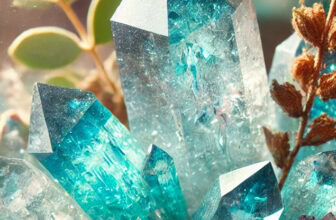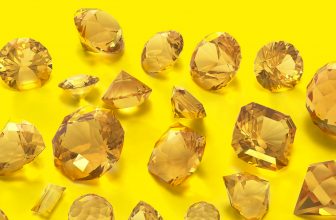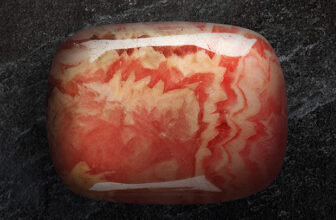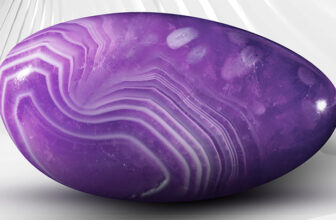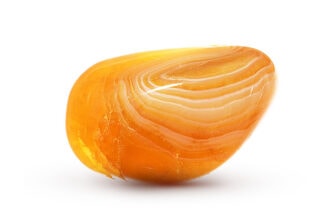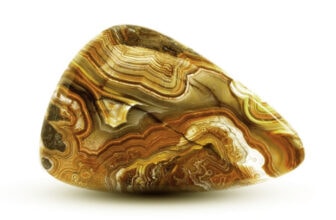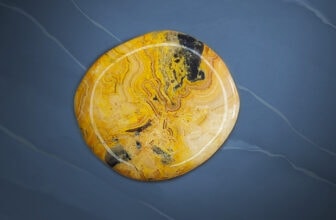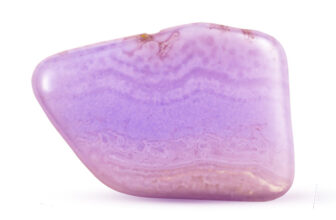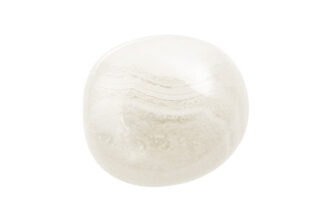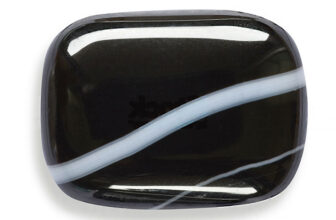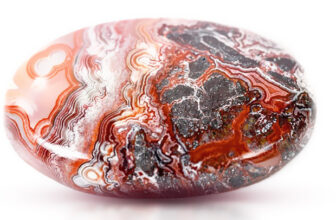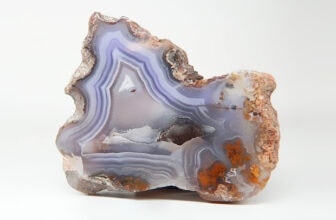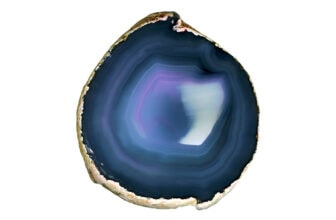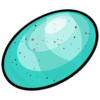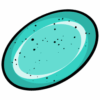Cabochons: Smooth Stones, Silent Power
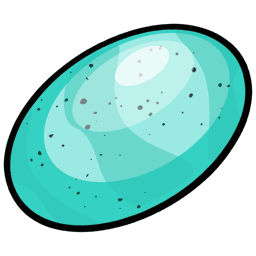 What makes a gemstone truly captivating? Is it the way light dances across its surface, or the quiet depth that seems to pull you inward? Not every gem needs a thousand glittering facets to tell its story – some reveal their magic in the simplest of forms. Enter the cabochon: smooth, domed, and irresistibly tactile.
What makes a gemstone truly captivating? Is it the way light dances across its surface, or the quiet depth that seems to pull you inward? Not every gem needs a thousand glittering facets to tell its story – some reveal their magic in the simplest of forms. Enter the cabochon: smooth, domed, and irresistibly tactile.
A cabochon is a gemstone that’s shaped and polished rather than faceted. Instead of sharp edges and mirror-like planes, it presents a gently convex top – a soft dome – and a flat or slightly curved base. This form isn’t just aesthetic preference; it’s a purposeful design that has endured for millennia.
In the world of crystal shapes and forms, the cabochon stands apart. Where faceted gems chase brilliance and sparkle, cabochons offer stillness – a serene glow, a concentrated color, a sense of grounded beauty. They’re the form of choice for stones that thrive on texture and depth rather than refraction: turquoise, opal, moonstone, jasper, and many others.
And here’s the delightful twist – some of the most mesmerizing optical effects in the mineral world only appear because of this cut. Chatoyancy (the cat’s-eye shimmer), asterism (the star-like radiance), and adularescence (the moonstone’s inner glow) all rely on a smooth, domed surface. Without the cabochon, these phenomena would simply vanish.
The Evolution of the Cabochon Cut
Where did the word cabochon come from, and why does it sound oddly elegant? The answer lies in its roots. It comes from the Middle French caboche, meaning “head.” The connection is obvious once you picture the rounded, head-like dome of the stone.
Long before the invention of precise faceting tools, people shaped gemstones by hand – rubbing, sanding, and polishing them into smooth forms. In ancient Mesopotamia, Egypt, and Greece, cabochons were the dominant gemstone style, adorning amulets, rings, and royal adornments. The process was simple yet profoundly effective: smooth the surface until it gleamed, and the gem’s natural color and texture came alive.
It’s easy to imagine an ancient craftsman sitting by lamplight, holding a small piece of turquoise or carnelian, feeling its weight and potential. No machinery. No precision angles. Just instinct, patience, and stone.
Even as faceting techniques evolved during the Renaissance – when cutters discovered how to slice gems into many-sided prisms of light – the cabochon never disappeared. It simply found a new purpose. While clear, highly refractive gems like diamonds or sapphires thrived with faceting, opaque and phenomenon-bearing stones continued to shine best under the curved polish of the cabochon cut.
Over time, the cabochon became both a nod to tradition and a canvas for natural beauty. It represented a different kind of craftsmanship – less about perfection and more about expression.
Why Some Stones Are Born to Be Cabochons
Why do some gemstones seem to crave softness – that quiet curve instead of a sharp-edged glint? The answer lies in what the cabochon celebrates: not just how light enters a stone, but how it lives within it.
A Cut for Texture, Color, and Depth
Faceted stones capture brilliance. Cabochons, on the other hand, reveal character. When a gem is opaque or semi-translucent, there’s little light to refract within. Instead of chasing sparkle, lapidaries focus on what makes the stone interesting: swirling patterns, layered inclusions, earthy hues.
Think of turquoise, malachite, or jasper – stones whose stories are written in veins and clouds of color. Under a domed polish, their textures seem amplified, like a landscape revealed beneath glass. The cabochon gives them room to breathe, turning every irregularity into an artistic feature rather than a flaw.
The Perfect Stage for Optical Magic
Then there are gems that perform – those with phenomena that need the cabochon’s smooth curvature to shine.
- Asterism produces a star effect, as seen in star sapphires or rubies. The dome focuses light so the star appears to hover on the surface, shifting as you move the stone.
- Chatoyancy, the “cat’s-eye” shimmer, depends on a narrow band of light gliding across the stone’s face – chrysoberyl, tiger’s eye, and pietersite are perfect examples.
- Adularescence, that ethereal blue glow of moonstone, needs the domed surface to reveal its inner misty light.
Gentle on Softer Stones
Not every gem can handle the sharp edges and angles of a faceted cut. Stones with a hardness below 7 on the Mohs scale – like turquoise, opal, or lapis lazuli – can scratch easily. A domed, polished surface hides minor wear and preserves beauty longer. It’s a protective shape, one that forgives time and touch.
Design and Mood
From a design perspective, cabochons evoke calm. They offer depth over dazzle, color over sparkle. In jewellery, they anchor a piece, adding visual weight and balance. A ring with a faceted gem flashes when you move your hand; a cabochon glows steadily, like a quiet ember.
Jewellers often describe the cabochon as more “organic” or “earth-connected.” It’s not about light escaping from within – it’s about the stone’s essence resting on the surface.
When to Choose a Cabochon
If you’re wondering whether a cabochon is right for your project or collection, consider this:
- The stone is opaque or has mesmerizing internal patterns.
- It displays optical phenomena that need a curved surface.
- It’s relatively soft and benefits from a scratch-concealing polish.
- You prefer smooth, tactile jewellery that feels comforting to touch.
- You want color intensity or texture rather than sparkle and brilliance.
In short, choose a cabochon when you want your gemstone to speak softly but with confidence.
Styles and Expressions in Cabochon Craft
If you’ve ever browsed through a tray of cabochons, you’ll notice something delightful – no two seem quite the same. Some are round and symmetrical, others free-form and wild. Some rise gently like a hill at dusk; others soar sharply, catching every glint of light across their curve. The cabochon world is a playground of subtle variations, and each tells its own story.
The Classic Form
At its simplest, a cabochon is defined by a domed top and a flat base. This base allows the gem to sit neatly in a bezel setting – a metal rim that cradles it securely – while the dome catches the light in a smooth, continuous reflection.
The most common outline? Oval. There’s something naturally pleasing about that shape. Unlike a perfect circle, an oval feels organic, forgiving, alive. Our eyes are more comfortable with its slight asymmetry; it feels human. But you’ll also find cabochons cut into circles, rectangles, teardrops, hearts, and endless free-form silhouettes shaped by the raw stone itself.
The Language of Domes
Not all domes are created equal. Lapidaries speak of low domes, medium domes, and high domes – distinctions that completely alter a gem’s personality.
- A low dome feels modern and sleek, ideal for rings or minimalist jewellery.
- A high dome magnifies the stone’s internal color and structure, giving it presence – especially useful for optical-effect stones like star sapphires.
- A double cabochon (domed on both sides) appears almost sculptural, often used for transparent or translucent stones that can be viewed from either direction.
And then there are the bullet cabochons, rising into a pointed tip, often used in talismanic or energy-focused designs.
The Art of Free-Form
Sometimes, the rough stone decides its own fate. Instead of forcing a perfect symmetry, lapidaries follow the natural contours of the material – curves dictated by veins, color zones, or inclusions. These free-form cabochons often feel the most “alive.” They capture the raw spirit of the stone while still offering the polish and softness that define the cabochon family.
You might see an agate cabochon shaped like a river stone, or an opal that twists slightly to showcase its color play. These unique shapes often find their way into artisan or custom jewellery, where individuality matters more than precision.
Cabochons with a Purpose
Certain styles exist specifically to highlight optical effects:
- Star cabochons are shaped to display asterism – the star pattern must align perfectly under the dome.
- Cat’s-eye cabochons rely on a centered, linear reflection, so the lapidary must orient the stone precisely.
- Moonstones are cut to reveal that inner shimmer, the adularescent glow that seems to drift beneath the surface.
Material and Mood
Cabochons appear in an astonishing range of materials: opal, turquoise, onyx, jasper, malachite, chrysoprase, labradorite, obsidian, lapis lazuli, and beyond. Each material brings its own energy and aesthetic: from the calm sky-blue of turquoise to the mysterious depths of black onyx or the shifting iridescence of labradorite.
Together, these variations remind us that the cabochon isn’t a rigid formula. It’s a philosophy of shape – one that embraces smoothness, sensuality, and flow. Where facets seek precision, the cabochon seeks harmony.
Inside the Making of a Cabochon
Ever wondered how a rough, uneven stone becomes that silky, domed gem that seems to glow from within? The making of a cabochon is a blend of geometry and instinct – a process that feels almost meditative. Each step is deliberate, each curve shaped by hand and water and grit until the stone’s natural beauty fully awakens.
From Rough to Slab
It all begins with the rough – a raw piece of gemstone material, fresh from the earth. The lapidary studies its patterns, veins, and inclusions, deciding how best to showcase its strengths and hide its flaws. This decision alone can define the entire piece.
Once chosen, the rough is sliced into thin sections, or slabs, using a diamond-blade saw. Each slab becomes a potential cabochon. The goal is to find an area where color, pattern, or light plays beautifully across the surface.
Marking the Shape
Next comes the template stage. The cutter traces an oval, circle, or free-form outline on the slab using a metal or plastic template and an ink marker. The stone is then trimmed close to that line with a trim saw, creating a rough outline. It’s at this point that the stone starts to whisper its future shape – the lapidary can already sense where the dome will rise and how the patterns will curve beneath it.
Grinding and Shaping the Dome
The stone is attached to a dop stick (usually with wax), allowing for precise handling. This stage is almost sculptural. Using a series of diamond or silicon carbide wheels, the lapidary grinds away excess material, forming the gentle dome that defines the cabochon.
This is where balance matters most. Too flat, and the stone looks dull. Too high, and it becomes unstable in a setting. The cutter must maintain even curves and symmetry while respecting the stone’s natural flow – a delicate dance between control and surrender.
Each pass of the wheel is accompanied by a steady stream of water to cool the stone and prevent cracking. Slowly, the edges soften. The base is flattened. The dome begins to gleam under the workshop lights.
Sanding and Polishing
Once the shape is right, it’s time to refine. The lapidary moves through progressively finer grits – each one removing the scratches of the last. The sanding phase is where patience pays off: every tiny imperfection must vanish before polishing begins.
Finally comes the polish. Using felt or leather wheels with oxides (cerium, tin, or aluminum), the surface is brought to a mirror-like sheen. This final stage is almost hypnotic – a soft hum, a swirl of light, and suddenly, the stone looks alive.
When done well, the polish enhances not only the stone’s beauty but also its energy. Many lapidaries speak of this moment as a kind of quiet connection – the point when the stone “reveals its soul.”
Precision Meets Intuition
Though modern machines like the Diamond Pacific Genie make the process smoother, no two cabochons ever emerge exactly alike. Some stones require gentle handling – opal or turquoise, for instance, can crack if overheated or pressed too hard. Others, like quartz or agate, can handle more assertive shaping.
And for optical-effect stones – star sapphires, cat’s-eye chrysoberyls, moonstones – orientation is everything. The cutter must align the dome precisely so the star or shimmer sits perfectly in the center. A fraction of a millimeter off, and the magic fades.
The process ends where it began: with human touch. The lapidary detaches the gem from its dop stick, wipes away the wax, and turns it under light. The cabochon gleams – smooth, soft, and full of quiet power.
Choosing and Setting the Perfect Cabochon
Imagine opening a drawer filled with polished domes of color – turquoise blues, moonstone silvers, jasper reds swirling like storm clouds. Each cabochon is distinct, quietly radiant, and waiting to be transformed. But how do you choose the right one? And once chosen, how do you give it the setting it deserves?
Choosing the Perfect Cabochon
A good cabochon should feel right before it even looks right. Pick one up – does it sit comfortably in your palm, or catch the light in a way that feels alive? Beyond that intuitive response, there are a few key things to notice:
- Symmetry & Shape – The dome should be even, with smooth curves and no flat spots. A lopsided dome can make a gem look unbalanced once set.
- Polish Quality – Look for a consistent, glassy shine. Dull patches or tiny scratches suggest incomplete polishing.
- Base Integrity – The bottom should be flat (or evenly curved, if double-domed), with no chips or rough edges that could affect setting.
- Color & Pattern – In opaque stones, color distribution and texture matter more than clarity. Seek even tones or captivating natural patterns like dendrites or inclusions.
- Optical Alignment – For stones with asterism or chatoyancy, make sure the effect is centered and moves correctly under light.
A truly fine cabochon draws you in quietly – not through brilliance, but through presence.
How Cabochons Are Set
Cabochons naturally lend themselves to bezel settings – a smooth metal rim that encircles and secures the stone. This design not only protects the edges (especially important for softer materials) but also enhances the cabochon’s gentle glow.
In a well-made bezel, the height of the wall should match the curve of the dome so the gem feels both cradled and revealed. A bezel that’s too low may not hold the stone securely; one that’s too high can hide its beauty.
Other settings – prong, flush, or channel – can work too, especially in mixed-style jewellery. But the cabochon’s flat base and rounded top make the bezel the natural partner. It’s a design that feels ancient, protective, and tactile.
Design Aesthetics & Emotional Appeal
Cabochons exude a mood. They’re not flamboyant; they’re steady, grounded, and quietly luxurious. Designers often use them to anchor a piece – the central calm around which everything else revolves.
A ring with a faceted gemstone sparkles as you move; a ring with a cabochon glows. The difference is almost emotional. One catches the eye; the other holds it.
Cabochon jewellery pairs beautifully with vintage or bohemian aesthetics, but it also thrives in minimalist settings. A single domed moonstone on a slender gold band can feel as modern as any cutting-edge design.
Try mixing cabochons with faceted stones for contrast – the interplay of glow and sparkle creates visual rhythm. For instance, a smooth labradorite center stone surrounded by tiny faceted spinels feels both grounded and luminous.
Care and Longevity
Because many cabochon-cut gems are softer or opaque, a little care goes a long way.
- Avoid harsh cleaners or ultrasonic devices; use mild soap and a soft cloth instead.
- Store pieces separately to prevent surface scratches on the dome.
- Be mindful with opal, turquoise, and other porous stones – they appreciate gentle handling and stable conditions.
When to Choose a Cabochon
Choose a cabochon when you want jewelry that whispers rather than shouts – when you value serenity over spectacle. They suit people who love texture, warmth, and meaning in their adornments.
Whether you’re drawn to the cool gleam of moonstone, the earthy steadiness of jasper, or the mysterious flash of labradorite, the cabochon gives these stones a voice that’s calm but confident.
Popular Cabochon Varieties
The cabochon cut invites the essence of a gemstone to come forward – its color, texture, and energy, rather than its brilliance. For this reason, not all gems suit faceting, but many come alive under a cabochon polish. Below are some of the most cherished varieties and what makes each one special when shaped into a smooth dome.
Classic Cabochon Favorites
- Moonstone – Its soft adularescence, that ghostly blue or silver sheen floating beneath the surface, is only visible in cabochon form. A properly aligned moonstone cabochon seems lit from within – like moonlight captured in glass.
- Labradorite – Known for its spectral “labradorescence,” this stone reveals hidden flashes of green, blue, and gold. Only a domed cut can show this phenomenon across the curved surface as the gem moves.
- Turquoise – An ancient favorite prized for its tranquil blues and greens, turquoise is opaque and naturally porous – ideal for cabochon cutting. Its soft, matte luster glows when polished into a rounded form.
- Opal – The play of color in opal – fire that dances across milky depths – emerges best when carved as a cabochon. The smooth surface acts like a window into another world, magnifying its shifting hues.
- Malachite – With its banded green swirls, malachite’s story is written in layers. A flat facet would disrupt those natural patterns; a cabochon, by contrast, amplifies their rhythmic beauty.
- Jasper & Agate – These earthy varieties thrive in cabochon form. From scenic picture jaspers to translucent moss agates, their unique inclusions become landscapes beneath the polish.
- Onyx & Chalcedony – The cabochon brings out their depth and serenity. A black onyx dome, especially, has an almost liquid richness that embodies quiet sophistication.
Gems Chosen for Optical Phenomena
Some gemstones are cut only as cabochons to reveal rare light effects:
- Star Sapphires & Star Rubies – Tiny needle-like inclusions reflect light into a six-rayed star. Only a cabochon with the correct dome height and orientation allows this magic to appear.
- Cat’s Eye Chrysoberyl – Exhibits chatoyancy: a single, silky band of light gliding across the surface like an eyelid opening. The effect vanishes in a faceted cut but shines in a cabochon.
- Asteriated Quartz, Garnet, and Spinel – Though rarer, these also display star effects when domed and polished.
Special-Interest and Collector’s Cabochons
Collectors adore unique cabochons not just for their beauty but for their personality.
- Dendritic Agate – Looks like miniature forests or ferns frozen inside the stone. Each one is a tiny landscape painting.
- Pietersite & Tiger’s Eye – The fibrous structure creates mesmerizing motion under light – chatoyant waves that seem to breathe.
- Larimar – Found only in the Dominican Republic, its sky-blue marbling evokes sunlight on Caribbean waters.
- Charoite – Swirls of violet and lavender with a pearly sheen – mystical and rare, best expressed through a large, bold cabochon.
Cabochons as Objects of Beauty and Meaning
There’s something deeply meditative about collecting cabochons. They’re not just unfinished gems – they’re small worlds, complete in themselves. Whether you’re a jeweller, lapidary artist, or crystal enthusiast, cabochons offer both creative potential and aesthetic satisfaction.
For Jewellery Makers
Cabochons are the artist’s palette. Their variety of shapes, from perfect ovals to freeform contours, allows designers to play with flow and balance in a piece. Because they can’t rely on sparkle, cabochon-based designs emphasize form and feeling.
- Try mixing materials: silver with turquoise for rustic charm, or gold with opal for timeless luxury.
- Asymmetrical designs work beautifully with cabochons, especially freeforms that echo organic shapes found in nature.
- Wire wrapping and bezel work are both ideal ways to express creativity with minimal interference to the stone’s integrity.
For Collectors and Crystal Lovers
To hold a cabochon is to hold a moment of stillness. Many collectors describe the tactile pleasure as grounding – the weight, the curve, the polish all inviting calm. Cabochons also serve beautifully as:
- Pocket companions or meditation stones – their smoothness encourages mindfulness.
- Display pieces – arranged by color or mineral type, they create small galleries of natural beauty.
- Energetic tools – those who practice crystal healing often prefer cabochons for body layouts or energy grids, as the smooth shape radiates gently and evenly.
Evaluating and Caring for Your Collection
When collecting, pay attention to craftsmanship as much as material. A well-cut cabochon should have:
- Balanced proportions and a well-centered dome.
- Even polish with no dull or “orange peel” areas.
- Secure backing or stabilizing (in stones like turquoise or opal) noted honestly by the seller.
To preserve their glow:
- Store cabochons separately in soft cloths or pouches.
- Avoid temperature shocks and chemical exposure.
- Handle them often – a light natural polish from touch can enhance their luster over time.
Why Cabochons Endure
Cabochons appeal to something primal. They echo ancient jewellery traditions – Egyptian scarabs, Roman intaglios, Celtic amulets – yet remain strikingly modern in their simplicity. Their power lies in their subtlety.
Where a faceted gem dazzles, a cabochon invites contemplation. It asks you not to look at it, but into it.
Perhaps that’s why collectors keep coming back – for the quiet connection between human craft and Earth’s artistry. Every cabochon is a dialogue: between nature and hands, light and curve, color and feeling.
Symbolism and Sacred Meaning
From the earliest human adornments to contemporary jewellery design, the cabochon has carried quiet power. Before brilliance and precision cutting became the measure of a gem’s worth, smoothness and luminosity defined beauty. The cabochon was the first, the oldest, the most human of all cuts – a form shaped by hand and touch rather than by geometry.
Ancient Origins: Stones of Power and Prestige
Long before diamonds sparkled in crowns, polished stones gleamed in amulets and talismans. The ancient Egyptians carved lapis lazuli, carnelian, and turquoise into smooth domes and scarabs, believing these forms enhanced their protective and spiritual energy. A polished surface was considered alive – it reflected divine light, symbolizing the eternal cycle between Earth and sky.
In Mesopotamia, cabochon-like seals were engraved with sacred symbols and worn as both identification and spiritual protection. Across ancient Greece and Rome, domed gems like chalcedony and agate were set into gold rings, sometimes engraved with mythic scenes or gods. Their curved polish caught soft, flickering light – a symbol of divine favor and inner wisdom.
Medieval and Renaissance Eras: The Mystical Glow of Faith
Through the Middle Ages, cabochons adorned reliquaries, crowns, and church ornaments. Opaque and translucent gems such as garnet, amethyst, and sapphire were treasured for their inner glow – a metaphor for the soul illuminated by faith. The rounded surface was seen as pure and complete, free from the vanity of sparkle.
Renaissance jewellers later refined the cabochon to emphasize color harmony and symbolic meaning. Rubies represented divine love; emeralds, rebirth and vision; sapphires, spiritual truth. Kings and queens wore cabochon gemstones not just for beauty but for their reputed metaphysical virtues – protection, wisdom, and clarity in leadership.
Modern Rediscovery: A Return to Authentic Beauty
By the 19th and 20th centuries, as faceted gems dominated the market, cabochons found new life through the Arts and Crafts and Art Nouveau movements. Designers like René Lalique and William Morris sought to reconnect artistry with nature, embracing cabochons for their organic, unpretentious charm.
Their jewellery celebrated imperfections – inclusions, clouds, and veins – as natural signatures of authenticity. This shift marked a deeper cultural recognition: beauty need not dazzle to be profound.
Symbolism of the Cabochon Form
The cabochon’s smooth dome represents wholeness, calm, and unity. In sacred geometry, the curve echoes the celestial sphere – endless, continuous, protective. Many believe that by polishing away edges and angles, the cabochon amplifies the essence of the stone rather than dispersing it.
- The dome symbolizes ascension – the soul’s rise toward light.
- The flat base represents grounding – our rootedness in the physical world. Together, they embody balance: the harmony of matter and spirit, earth and sky.
This symbolic geometry makes cabochons powerful focal points in amulets, healing jewellery, and meditation tools. They are the bridge between the tactile and the transcendent.
Soul of the Stone
Beyond their visual grace, cabochons hold a reputation for enhancing the energetic presence of a gemstone. Because they have no sharp edges, their energy is said to flow more smoothly and evenly – resonating gently with the human aura.
Energy Flow and Amplification
Faceted stones emit energy in focused bursts, like light refracted through a prism. Cabochons, by contrast, radiate – their rounded form diffuses energy softly, creating a sense of calm and steady vibration. Many crystal practitioners prefer cabochons for emotional healing, meditation, and energy work because:
- The shape encourages balance and receptivity.
- The energy feels grounding and nurturing rather than stimulating.
- The tactile surface enhances mindful connection during use.
Cabochons are often placed directly on the body – over chakras, the heart, or the palms – to harmonize subtle energy flow. Their form allows the natural essence of the stone to work without interference, much like still water reflecting the sky.
Metaphysical Significance of Popular Cabochon Stones
- Moonstone – Symbol of intuition, feminine energy, and emotional healing. The cabochon accentuates its inner light, encouraging reflection and new beginnings.
- Labradorite – Stone of transformation and protection. In cabochon form, its shifting colors mirror the fluid nature of the self and strengthen psychic awareness.
- Turquoise – Bringer of serenity, communication, and truth. A domed turquoise cabochon feels like a piece of the sky made solid.
- Amethyst – Calming, spiritual, and clarifying. The cabochon cut intensifies its soothing energy, ideal for meditation or restful sleep.
- Malachite – Guardian of the heart chakra. Its swirling patterns embody personal growth and emotional release.
- Opal – Enhances inspiration, imagination, and emotional expression. A cabochon reveals the dance of color – symbolizing creativity awakening.
- Rose Quartz – Radiates compassion and self-love. The rounded form amplifies its soft, nurturing frequency.
Each stone’s natural vibration is deepened through the cabochon shape, which acts like a resonant vessel – gentle, protective, and intimate.

